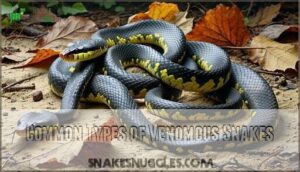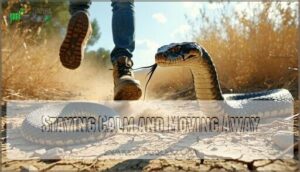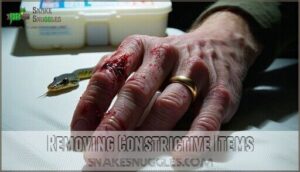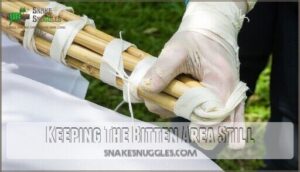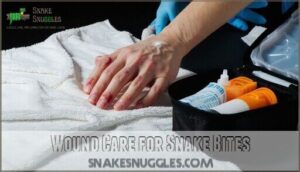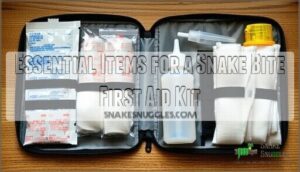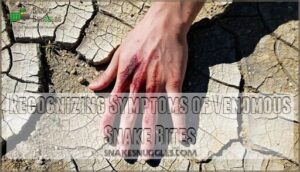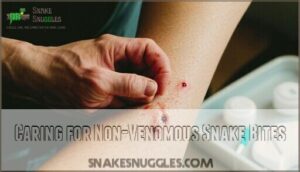This site is supported by our readers. We may earn a commission, at no cost to you, if you purchase through links.
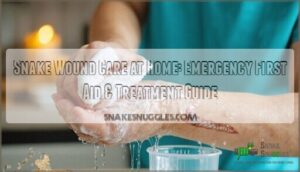
Gently clean the bite with soap and water, then apply light pressure with a clean cloth.
Keep the affected area still and slightly elevated if possible.
Don’t fall for old wives’ tales about sucking out venom or applying ice; these methods can actually make things worse.
Remove any tight jewelry or clothing near the bite before swelling starts.
Think of it as buying time until professional help arrives, knowing which steps actually help versus which ones just feel like they should work, and understanding the importance of taking the right actions to ensure the best possible outcome.
Table Of Contents
- Key Takeaways
- Identifying Venomous Snakes
- Immediate Response to Snake Bites
- Wound Care for Snake Bites
- Common Mistakes in Snake Bite Treatment
- Essential Items for a Snake Bite First Aid Kit
- Recognizing Symptoms of Venomous Snake Bites
- Preparing for Medical Help
- Risks of Delayed Medical Treatment
- Caring for Non-Venomous Snake Bites
- Preventing Snake Bites at Home
- Frequently Asked Questions (FAQs)
- How to care for a snake bite?
- How do you treat a snakebite wound?
- What is the treatment for a non-venomous snake bite?
- What to do after a snakebite?
- What to do if a snake dies?
- Should a snake bite be treated as a medical emergency?
- What can I put on my snakes wound?
- How to take care of a snake wound?
- How to disinfect a wound on a snake?
- Can snakes heal from wounds?
- Conclusion
Key Takeaways
- Stay calm and act fast – You’ll need to immediately move away from the snake, remove tight jewelry or clothing before swelling starts, then gently clean the wound with soap and water while keeping the affected area still and below heart level.
- Don’t fall for dangerous myths – You shouldn’t suck out venom, apply ice, or use a tourniquet as these methods can actually worsen tissue damage and complications rather than help with recovery.
- Focus on proper wound care basics – You’ll want to apply gentle pressure with a clean cloth, elevate the limb if possible, and use basic immobilization techniques while waiting for professional medical help to arrive.
- Get emergency medical attention immediately – You can’t treat venomous snake bites at home alone, and even non-venomous bites need professional evaluation since complications like infection or severe allergic reactions can develop rapidly.
Identifying Venomous Snakes
You can’t treat a snake bite properly if you don’t know whether the snake that bit you was venomous, and trust me, you don’t want to guess wrong on this one.
Learning to spot the key differences between harmless and dangerous snakes could save your life, so let’s break down the telltale signs that separate the garden-variety slitherers from the ones that pack a serious punch.
Physical Characteristics of Venomous Snakes
When identifying venomous snakes, head shape serves as your first clue—look for that distinctive triangular or wedge-shaped appearance that’s wider at the back and attached to a narrow neck.
Pupil shape offers another telltale sign: venomous species typically have slit-like, vertical pupils resembling a cat’s eye, while harmless snakes display round pupils.
Fang structure matters too, as larger fangs create deeper puncture wounds.
Coloration patterns vary widely, but many venomous snakes feature bright, distinct markings.
Some species even possess a rattling mechanism for warning potential threats.
Common Types of Venomous Snakes
North America’s venomous lineup includes rattlesnakes with their signature tail warning, copperheads sporting copper-colored heads and hourglass bands, and coral snakes flaunting red-yellow-black patterns.
Australia houses deadly taipans, while cobras and kraits dominate Asia.
Each species demands respect—their bite delivers potent venom requiring immediate snake bite wound care and professional treatment.
Geographic Distribution of Venomous Snakes
Understanding global snake habitats becomes your safety roadmap when exploring different regions.
Venomous snake ranges vary dramatically—rattlesnakes dominate North American deserts, while cobras rule Asian territories and taipans terrorize Australia.
Regional snake diversity creates unique snakebite risk areas worldwide.
Some invasive snake species have expanded beyond their natural boundaries, making snake identification and snake safety knowledge essential for effective snake bite prevention in any snake habitats you encounter.
Immediate Response to Snake Bites
When a snake strikes, your first few minutes can make the difference between a manageable situation and a medical emergency.
Every second counts when venom meets bloodstream—your quick thinking becomes the difference between recovery and catastrophe.
You’ll need to act quickly but thoughtfully, resisting the urge to panic while taking three critical steps that could save your life.
Staying Calm and Moving Away
Once you spot the venomous snake that bit you, panic control becomes your lifeline.
Take a deep breath and create a safe retreat – back away slowly without sudden movements.
Don’t turn your back on the snake or try to catch it.
Focus on bystander safety too; warn others nearby.
Assessing danger means watching where you step while moving to safety for proper snake wound care at home.
Removing Constrictive Items
Remove rings, watches, and tight clothing immediately after a snake bite.
Swelling complications can trap jewelry, cutting off circulation and causing serious harm.
Don’t wait—clothing interference worsens as tissues expand.
This simple step prevents circulation concerns and allows room for proper bandage adjustments during snake wound care at home.
Keeping The Bitten Area Still
After removing tight jewelry and clothing, your next move is keeping that bitten limb absolutely still.
Movement acts like a pump, pushing venom through your system faster than you’d like.
Effective immobilization methods for snake wound care at home:
- Apply a makeshift splint using sticks or cardboard for stability
- Keep the affected area below heart level to slow circulation impact
- Avoid unnecessary movement while awaiting medical help
- Use bandaging techniques to secure immobilization without restricting blood flow
Wound Care for Snake Bites
Once you’ve moved to safety, proper wound care becomes your next priority and can make a real difference in your recovery.
You’ll need to clean the bite gently, apply controlled pressure, and keep the affected area positioned correctly while waiting for medical help.
Cleaning The Wound
Snake wound cleaning begins with gentle soap and water—think of it as giving the injury a careful bath.
Use sterile saline or mild antiseptic solutions to rinse away debris without harsh scrubbing. Safe products matter here; avoid alcohol or hydrogen peroxide that damage tissue.
Consider purchasing sterile solutions for ideal wound care.
This wound cleaning step sets the foundation for proper snake wound disinfection and healing.
Applying Gentle Pressure
After cleaning the wound properly, you’ll want to apply gentle pressure to control bleeding and prevent further complications. Think of it like giving the wound a firm but caring handshake – enough to help, not enough to hurt.
Pressure Bandaging helps with swelling control and provides tissue support around the bite area. This technique slows venom spread through your lymphatic drainage system, buying you valuable time before medical help arrives.
Here’s what gentle pressure accomplishes:
- Controls bleeding without cutting off circulation
- Reduces swelling and inflammation at the bite site
- Provides structural tissue support to damaged areas
- Helps prevent venom from spreading through lymphatic channels
Remember, you’re not trying to stop circulation completely – just applying steady, comfortable pressure for effective snake wound care.
Elevating The Affected Limb
After cleaning the wound, elevate the affected limb above your heart level—think of it as giving gravity a helping hand.
This simple snake wound care technique offers circulation benefits while reducing how fast venom spreads through your system. Proper limb positioning aids swelling reduction and provides some pain management relief.
Use pillows or cushions to keep the area raised comfortably. Remember that localized symptoms can include immediate pain and swelling.
It’s like putting your feet up, but with a medical purpose that could save your life.
Elevate Limb
Reduce Swelling
Improve Flow
Control Spread
Immobilizing The Affected Limb
After a snake bite, your limb needs to stay put like a statue.
Here’s your three-step immobilization game plan:
- Apply splints or slings using support materials to prevent venom from traveling further through your system.
- Secure with proper bandaging methods while performing circulation checks to confirm blood flow isn’t restricted.
- Maintain immobilization duration until medical help arrives, keeping that limb steady and below heart level.
Common Mistakes in Snake Bite Treatment
When panic strikes after a snake bite, you might grab for remedies that seem logical but actually make things worse.
Understanding these common treatment mistakes can mean the difference between proper healing and serious complications that’ll have you wishing you’d stuck to the basics.
Applying a Tourniquet
Movies make tourniquets look heroic, but they’re dangerous snake bite mistakes.
Tourniquet dangers include limb ischemia and tissue death from cutting off blood flow. Skip the dramatic field improvisation – you lack proper tourniquet training.
Instead, use pressure alternatives like gentle bandaging for snake wound care. Keep the bite below heart level and focus on immobilization until first aid professionals arrive.
Sucking Out The Venom
You’ve probably seen heroes suck snake bite venom in movies, but don’t try this snake bite venom removal method.
Forget Hollywood heroics—sucking venom from snake bites causes more harm than good.
These snake bite myths create dangerous snake bite misconceptions about first aid.
Here’s why venom extraction myths and ineffective suction devices don’t work:
- Removes minimal venom from the bite
- Infection possibility from mouth bacteria
- Tissue damage risks from aggressive suction
- Alternative first aid methods prove more effective
Using Ice or Cold Packs
Just like trying to suck out venom won’t help, grabbing ice or cold packs creates another dangerous mistake.
Your instinct might tell you that cold’s impact reduces swelling, but you’re actually causing more tissue damage.
Ice restricts blood flow, creating circulation effects that worsen the situation rather than providing pain relief.
Think of it like putting a tourniquet on your garden hose – nothing flows properly.
Snake wound care requires gentle warmth, not freezing temperatures.
Calling 911 promptly is essential for ensuring the best possible outcome.
Alternative methods like elevating the limb work better for snake injury home care.
Skip the Hollywood myths about treating snake wounds with ice.
Focus on proven snake first aid techniques instead of home remedies snake wounds that backfire.
Essential Items for a Snake Bite First Aid Kit
You’ll want to stock your first aid kit with essential supplies before you need them, because scrambling to find bandages while someone’s writhing from a snake bite isn’t exactly ideal timing.
A well-prepared kit should include clean bandages, antiseptic solutions, pain relievers, and splinting materials to handle the critical first steps of treatment, including the use of antiseptic solutions.
Bandages and Wound Cleaning Agents
Beyond avoiding common treatment mistakes, proper snake wound care supplies make all the difference. You’ll need sterile dressings and antiseptic solutions to prevent snake wound infection. Think of these items as your first line of defense—they keep wounds clean while you wait for help.
Here’s your essential wound cleaning toolkit:
- Sterile gauze pads for covering bite marks
- Antiseptic wipes containing alcohol or iodine
- Medical tape to secure bandages properly
- Non-stick pads that won’t pull at healing tissue
- Elastic wraps for gentle compression and wound protection
Cleaning frequency matters—change dressings daily. Consider purchasing bulk quantities here for frequent changes. Different bandage types serve different purposes, so stock various sizes. Your antiseptic choice can speed healing substantially.
Antivenom and Pain Relievers
Smart snake-bite preparation means understanding antivenom types and pain management essentials.
You can’t stock antivenom at home—it requires professional administration and refrigeration. However, knowing dosage guidelines and antivenom side-effects helps you communicate with medical teams.
For immediate snake wound care, focus on safe alternative analgesics like acetaminophen over aspirin.
- Antivenom accessibility: Hospital-only treatment requiring immediate professional care
- Pain relief safety: Acetaminophen beats aspirin for snake bite treatment
- Preparation strategy: Know symptoms to communicate effectively with emergency responders
Immobilization Devices
Along with pain relievers, you’ll need proper immobilization gear.
Splinting Techniques using SAM Splints or makeshift materials keep bitten limbs rock-solid. Compression Bandages like VetWrap and Elasticon provide gentle support without cutting circulation. Vacuum Splints work great, but DIY Immobilization with sturdy sticks does the trick too.
Remember to wash the wound with soap and water as part of essential snake bite management. Think "snug hug, not death grip"—your goal is stability, not strangulation.
Recognizing Symptoms of Venomous Snake Bites
You’ll need to spot the warning signs of venomous snake bites quickly, since symptoms can escalate faster than you’d expect and vary from mild local swelling to serious whole-body reactions.
Think of your body as a detective reporting clues—it’ll show you localized pain and swelling first, then potentially progress to nausea, breathing problems, or muscle weakness that signal you need emergency help immediately.
Localized Symptoms
You’ve assembled your first aid kit. Now let’s recognize what happens right at the bite site when venom hits tissue.
Pain assessment starts immediately—expect sharp, burning sensations that worsen quickly. Swelling severity increases within minutes, while redness progression spreads outward from puncture wounds. Tissue discoloration and bruising extent develop as venom damages blood vessels.
- Monitor snake wound symptoms every 15 minutes for changes
- Document swelling severity by measuring circumference if possible
- Watch redness progression spread beyond the immediate bite area
- Note bruising extent and purple discoloration patterns for medical teams
Systemic Symptoms
While localized symptoms stay put around the bite, systemic symptoms spread throughout your entire body like ripples in a pond.
These whole-body reactions signal that venom has entered your bloodstream and demands immediate attention.
Nausea Management becomes important as your stomach rebels.
Breathing Difficulties can develop quickly, making each breath feel labored.
Dizziness Causes stem from dropping blood pressure, while Muscle Weakness leaves you feeling drained.
| Early Systemic Signs | Severe Complications |
|---|---|
| Nausea and vomiting | Convulsions |
| Excessive sweating | Paralysis |
| Fast pulse | Spontaneous bleeding |
| Fever | Chest pain |
| Trouble breathing | Organ Failure |
Don’t wait—these symptoms worsen rapidly without proper reptile vet care equivalent treatment.
Neurotoxic Symptoms
Neurotoxic venom is like a silent saboteur, targeting your nervous system with frightening precision.
When certain venomous snakes inject neurotoxins, you’ll notice symptoms that spell serious trouble. These effects can escalate quickly, making immediate medical attention essential for proper snake wound care.
Watch for these warning signs:
- Drooping eyelids that won’t stay open
- Muscle weakness spreading through your body
- Swallowing difficulty making eating impossible
- Paralysis onset starting in extremities
Without swift antivenom treatment, respiratory failure becomes a real threat. Don’t wait—these symptoms demand emergency care, not home snake antibiotics or reptile antiseptic treatment.
Preparing for Medical Help
Once you’ve handled the immediate care, it’s time to get ready for professional medical help – think of it like calling the cavalry when you’re outgunned by venom.
You’ll need to know when to head to the hospital, what doctors will do once you arrive, and how to handle recovery afterward.
When to Seek Immediate Medical Attention
When escalating symptoms like severe swelling, breathing trouble, or dizziness appear, don’t hesitate—head to the emergency room immediately.
Systemic reactions and neurotoxic signs demand professional care, especially in children and elderly victims.
If you notice infection risks developing or suspect venomous snake involvement, medical professionals with antivenom access can provide life-saving treatment that home remedies simply can’t match.
What to Expect at The Hospital
Once you arrive at the hospital, expect a thorough Hospital Assessment where medical staff evaluate your bite’s severity.
The emergency team will likely begin Antivenom Administration if needed, followed by thorough Pain Management to keep you comfortable.
Throughout your stay, nurses will focus on Monitoring Signs like blood pressure and heart rate.
Here’s your typical hospital experience:
- Wound Assessment to determine treatment needs
- IV fluids and medical care-level monitoring
- Recovery Timeline discussion with your medical team
Follow-up Care and Rehabilitation
Your hospital stay’s just the beginning of your snake recovery journey.
Followup care keeps you on track toward full healing.
You’ll likely need physical therapy to regain strength and mobility in the affected area.
Don’t skip these appointments—they’re your ticket back to normal function.
Medication management becomes part of your daily routine.
Pain relievers, antibiotics, and anti-inflammatory drugs need careful timing and dosing.
Scar management techniques help minimize lasting marks from the bite.
The mental side matters too.
Psychological support addresses any lingering fears about future snake encounters.
Some folks develop anxiety that affects their outdoor activities.
Lifestyle adjustments might include new safety habits or modified exercise routines during wound healing.
Snake rehabilitation isn’t just physical—it’s rebuilding confidence in your environment.
Risks of Delayed Medical Treatment
When you delay getting medical help after a snake bite, you’re basically playing Russian roulette with your health—complications can snowball from manageable to life-threatening faster than you’d expect.
Every minute that passes without proper treatment gives venom more time to spread through your system, potentially causing permanent nerve damage, tissue death, or worse.
Complications From Untreated Snake Bites
Ignoring snake bites brings serious snake wound complications.
Tissue necrosis can destroy healthy skin, while systemic infections spread throughout your body.
You’re looking at amputation risks if circulation fails completely.
Organ damage affects your heart and kidneys, plus chronic pain that won’t quit.
Rattlesnake venom potency varies substantially between bites, influencing the severity of the outcome.
Snake skin infection and poor snake wound healing make recovery harder.
Don’t gamble with infected wounds.
Importance of Prompt Medical Attention
Every minute counts when dealing with venomous snake bites. Envenomation severity increases rapidly without proper antivenom efficacy, dramatically affecting mortality rates.
Treatment windows close quickly—your best shot at avoiding long-term effects happens within the first few hours.
Here’s why speed matters:
- Antivenom works best when given early, like catching a bus before it leaves
- Snake bite treatment becomes less effective as venom spreads through your system
- Reptile veterinarian expertise can mean the difference between full recovery and permanent damage
- Snake wound healing improves substantially with professional snake wound care
- Reptile wound treatment protocols save lives when time isn’t wasted
Caring for Non-Venomous Snake Bites
Non-venomous snake bites might feel like getting pinched by nature’s grumpiest garden hose, but they’re much easier to handle than their dangerous cousins.
You’ll still need proper wound care and infection monitoring, since even harmless snakes carry bacteria that can cause problems if ignored.
Cleaning and Treating The Wound
Non-venomous snake bites need proper wound cleaning to prevent complications.
Start by washing your hands, then gently rinse the bite with clean water and mild soap for several minutes. For specialized cleaning, consider wound cleaning solutions.
Pat dry with sterile gauze and apply antiseptic solutions like chlorhexidine. Use proper bandaging techniques with non-stick dressing for infection control and healing promotion.
Clean the wound
Prevent infection
Sterile dressing
Monitoring for Signs of Infection
After cleaning the wound properly, watch for infection like a hawk watching its prey.
Your snake’s body will send clear signals if something’s going wrong with reptile wound care.
Monitor these red flags that scream "infection alert":
- Redness spreading beyond the original wound site
- Swelling that worsens instead of improving over time
- Pus or unusual discharge with foul odors
- Elevated temperature in your snake or increased pain
Delayed healing means trouble’s brewing.
Apply antiseptic regularly and prioritize reptile health by catching infection early.
Preventing Future Bites
Smart snake injury prevention starts with your surroundings.
Keep your yard maintenance current by clearing brush and sealing gaps. Practice hiking safety with sturdy boots and trail awareness.
Educate kids through children education about snake habitats. Pet protection means supervised outdoor time.
Remember: prevention beats treatment every time.
| Prevention Area | Action Required | Peace of Mind Level |
|---|---|---|
| Home & Yard | Clear debris, seal holes | High – your safe zone |
| Outdoor Activities | Wear boots, stay alert | Medium – controlled risk |
| Family Safety | Teach kids, supervise pets | High – everyone protected |
Preventing Snake Bites at Home
You can’t avoid every snake encounter, but smart prevention beats emergency first aid every time.
By keeping your yard tidy, wearing proper gear, and staying alert outdoors, you’ll turn most snake surprises into harmless "nope, not today" moments.
Avoiding Snake Habitats
Understanding where snakes hang out can save you from an unwanted encounter. Yard Maintenance becomes your first defense against these slithery visitors who love messy spaces.
Snakes seek shelter in tall grass, wood piles, and rock heaps where they can hide and hunt. Snake safety starts with keeping your property tidy and sealing small holes around your home.
Here are key snake bite prevention tips for habitat avoidance:
- Clear debris piles and overgrown vegetation regularly
- Trim grass short and remove fallen branches
- Seal gaps under porches, sheds, and foundations
- Store firewood away from your house on raised platforms
- Remove water sources like leaky hoses or standing puddles
Awareness Education about snake bite safety precautions helps create surroundings awareness.
Wearing Protective Clothing
Knowing snake habitats helps, but your gear acts like personal armor when you’re outdoors.
Smart clothing choices can mean the difference between a close call and a trip to the emergency room for snake wound care.
Here’s your protective clothing checklist:
- Snake-proof boots with thick leather or synthetic materials reaching mid-calf
- Heavy denim or canvas pants that resist puncture wounds
- Thick work gloves when handling brush, woodpiles, or garden areas
- High-visibility gear so you can spot snakes before they spot you
Being Aware of One’s Surroundings
When venturing outdoors, your eyes become your first line of defense against snake encounters.
Trail awareness means scanning ahead while walking, especially near rocks, logs, or thick vegetation. Use your peripheral vision to catch movement in grass or brush. Sound detection helps too—listen for rustling that might signal a snake’s presence.
Seasonal activity patterns matter since snakes are more active during warmer months.
| Awareness Technique | Key Focus Areas | Safety Benefits |
|---|---|---|
| Visual Scanning | Ground ahead, vegetation edges | Early snake detection |
| Habitat Recognition | Rock piles, water sources | Avoids high-risk zones |
| Sound Awareness | Rustling, movement sounds | Alerts to nearby snakes |
| Peripheral Monitoring | Side vision coverage | Catches unexpected movement |
| Seasonal Vigilance | Temperature-based activity | Prevents surprise encounters |
Frequently Asked Questions (FAQs)
How to care for a snake bite?
Every year, roughly 4 million people get bitten by snakes worldwide.
If you’re bitten, stay calm, clean the wound gently, remove tight jewelry, keep the area still, and get medical help immediately.
How do you treat a snakebite wound?
Clean the bite gently with soap and water, then cover with a clean bandage.
Remove jewelry near the wound, keep it below heart level, stay calm.
Get emergency medical help immediately.
What is the treatment for a non-venomous snake bite?
Though non-venomous bites won’t kill you, they still need attention.
Clean the wound with soap and water, apply antibiotic ointment, bandage it, and watch for infection signs like redness or swelling.
What to do after a snakebite?
Stay calm and move away from the snake immediately.
Clean the wound gently with soap and water, remove tight jewelry, keep the bite below heart level.
Seek emergency medical attention right away.
What to do if a snake dies?
Ironically, a dead snake can still bite reflexively for hours.
Don’t touch it with bare hands. Use tools or thick gloves to remove it safely.
Dispose of the body properly to avoid attracting scavengers.
Should a snake bite be treated as a medical emergency?
Yes, you should always treat snake bites as medical emergencies.
Even non-venomous bites can cause infection or allergic reactions.
Don’t wait to see symptoms—get immediate medical attention to stay safe.
What can I put on my snakes wound?
Snake wounds heal remarkably fast—often within days for minor injuries.
You’ll want diluted povidone-iodine or chlorhexidine solution for cleaning, then apply reptile-safe antibiotic ointment like Vetericyn Plus.
Avoid hydrogen peroxide completely.
How to take care of a snake wound?
Clean your snake’s wound with diluted povidone-iodine or chlorhexidine.
Apply reptile-safe antibiotic ointment like Vetericyn Plus.
Cover with sterile, non-adhesive bandages changed daily.
Monitor for infection signs and maintain a warm, clean habitat.
How to disinfect a wound on a snake?
Use diluted povidone-iodine or chlorhexidine solution to gently clean the wound. Avoid hydrogen peroxide since it damages tissue. Apply reptile-safe antibiotic ointment like Vetericyn Plus afterward for proper healing.
Can snakes heal from wounds?
Your snake’s body has remarkable healing powers.
Minor wounds close within days, while deeper injuries need weeks.
They can’t regrow lost body parts, but their natural recovery abilities are quite impressive with proper care.
Conclusion
Remember, you’re not expected to become a wilderness survival expert overnight, but mastering snake wound care at home could literally save a life.
Keep your head cool, clean the wound gently, and resist the urge to play hero with outdated remedies.
Time is your ally when you follow proper first aid steps.
Most importantly, get professional medical help fast—because in the case of snake bites, there’s no substitute for real medical expertise and proper treatment.


